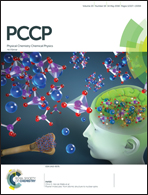Exploring function activated chlorins using MCD spectroscopy and DFT methods: design of a chlorin with a remarkably intense, red Q band†
Abstract
The electronic structures of three previously synthesized Ni-coordinated chlorins with β-substituents of thioketone, fluorene, and ketone were investigated using magnetic circular dichroism spectroscopy (MCD) and density functional theory (DFT) for potential application as sensitizers for dye-sensitized solar cells (DSSCs). Computational studies on modeled Zn-coordinated chlorins allowed identification of charge transfer and d–d transitions of the Ni2+ coordinated chlorins. Two fictive Zn chlorins, M1 and M2, were designed with thiophene units based on the fluorene substituted chlorin. Substitution with thiophene altered the typical arrangement of the four Gouterman molecular orbitals (MOs) and red-shifted and greatly intensified the lowest energy absorption band (the Q band). The introduction of the thiophene-based MO as the LUMO below the usual Gouterman LUMO is predicted to increase the efficiency of electron transfer from the dye to the conduction band of the semiconductor in DSSCs. The addition of a donor group on the opposite pyrrole (M2) red-shifted the Q band further and introduced a donor-based MO between the typical Gouterman HOMO and HOMO−1. Despite the relatively small ΔHOMO, M1 and M2 exhibited remarkably intense Q bands. M2 would be a possible candidate for application in DSSCs due to its panchromatic absorption, intense and red-shifted Q band, and the presence of the substituent based MO properties. Another indicator of a successful dye is the alignment of the ground state and excited state oxidation potentials (GSOP and ESOP, respectively) with respect to the conduction band of the semiconductor. The GSOP for M2 lies 0.55 eV below the I−/I3− redox potential and the ESOP lies 0.48 eV above the TiO2 conduction band. The impact of the thiophene dominance in the LUMO also supports the prediction of efficient sensitization properties. The remarkably intense Q band of M2 predicted to be at 777 nm with a ΔHOMO of just 1.04 eV provides a synthetic route to tetrapyrroles with extremely intense, red Q bands without the need for aza nitrogens of the phthalocyanines. This study illustrates the value of guided synthesis using MCD spectral analysis and computational methods for optimizing the design of porphyrin dyes.

- This article is part of the themed collection: 2018 PCCP HOT Articles


 Please wait while we load your content...
Please wait while we load your content...